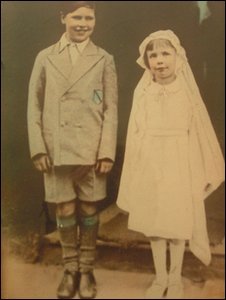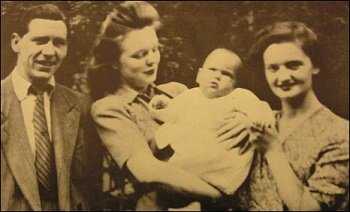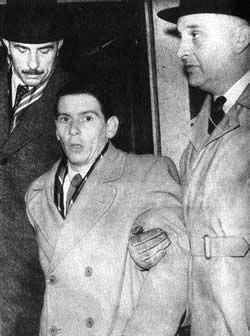Timothy Evans, Convicted Killer

There are few crimes that provoke such anger as the murder of a child. And when the child in question has been killed by one of their parents, the very people who should be taking care of them – then our rage can be uncontrollable. One person who was convicted and executed for this terrible crime was Timothy Evans. He was born in 1924 in the Welsh town of Merthyr Tyfdil. The town was named for St Tyfdil, a Welsh woman martyred by invading “Irish and Picts”. Evans had a reputation as a playful child, but one prone to inventing wild and fanciful stories. His father abandoned the family shortly after he was born, and his mother remarried to a man named Probert in 1929. This gave Evans a step-brother to join his older sister, and eventually a younger sister as well.
At that time the town’s steel industry was in steep decline, and Timothy’s family, like many others, moved to London in 1935. Young Evans worked part time to help fund the family, spending the rest of his time at school. He was a poor student, due at least in part to an injury to his foot as a child that forced him to miss school for quite a while. The injury became infected and took years to heal, troubling him repeatedly thereafter. As a result of this he remained functionally illiterate for the rest of his life. At the age of thirteen he moved back to Merthyr Tyfdil to work in the coal mines, but his foot continued to trouble him and eventually he had to give it up. He went back to London in 1939, just as the second World War broke out. Despite turning 18 during the conflict, his injury meant that he was never called up for national service.

Evans was working as a delivery driver when he met a woman named Beryl Thorley. The two were married in 1947, and originally lived with the extended Evans/Probert family. When Beryl became pregnant they decided to move out and into a flat just around the corner in Rillington Place. They had the top floor of a building, and their downstairs neighbours were John and Ethel Christie. Christie was an ex-serviceman who had been gassed in the trenches during World War I, and had served as a Special Constable during the Blitz. The much younger Evans seems to have found him very impressive. John and Ethel had been separated for a long period and were now trying to give their marriage another go, and this may have been a common point between the two men. For the marriage of Timothy and Beryl Evans was far from a happy one. The two fought constantly – over the family finances (which Beryl was incapable of managing), and over John’s drinking (which only escalated as they fought). Several neighbours would later report seeing the two physically attacking each other. A crisis point was reached in the middle of 1949, when Beryl discovered she was pregnant again. The two could not afford a second child, so they decided to resort to an abortion, which was at the time illegal.
Several weeks later, on the 30th November 1949, Timothy Evans walked into a police station in Merthyr Tyfdil. He told the police that he had come to give himself up, and that his wife had died in London after drinking a poison that was meant to induce an abortion. [1] He had hidden her body in a drain in front of the house, given their daughter into care, and then fled. The police immediately arrested him and moved him back to London, where they investigated the drain. Not only did they not find a body, they also realised that there was no way Evans could have lifted the cover (it took three policemen to move it). On being confronted with this, Evans changed his story. He now claimed that it was Christie who had procured the substance, who had told him his wife died while drinking it, and who had told him to flee while he hid the body. His earlier story had been an attempt to protect the other man. Christie, on being confronted, absolutely denied this. The police searched the back garden of the flat, and found Beryl’s body in a shed. She was not alone – the body of Geraldine Evans, the thirteen month old daughter, was also found beside her. Both of them had been strangled.

On the 11th of January the trial began of Evans for the murder of his daughter Geraldine. (As was standard practice on capital charges like this, the murder of Beryl was placed “on file”, since Geraldine’s murder was considered the more serious. If the first charge had led to a mistrial, then the second could have been used to retry him.) The police had a signed confession from Evans that he had murdered his wife and daughter, and the trial was considered an open and shut case. Both John and Ethel Christie testified to having seen Evans and his wife fight violently, and John also denied Evans’ testimony. The defence tried to argue that it must have been Christie who had committed the murders, and managed to drag up some evidence of him having been prosecuted for acts of violence in the past. Still, his respectable reputation as a Special Constable and his lack of any motive meant that the judge and the jury never really took this accusation seriously. Evans’ own lack of credibility, as evidenced by his original false story and his somewhat scatter-brained behaviour while in custody, made him a much more viable suspect. The judge summed up against Evans, and the jury took only forty minutes to convict him. His appeal failed, and on the 9th March 1950 he was executed by Albert Pierrepoint. Another triumph for British justice.
Except, of course, he didn’t do it.
In March 1953 the new tenant of the house on Rillington Place, an immigrant from the West Indies named Beresford Brown, found a concealed door to a pantry beneath the wall paper in Christie’s old kitchen. (Christie had been evicted a few days earlier for subletting his flat.) In the pantry Brown made a gruesome discovery. Bundled into the tiny recess were the bodies of three women, all strangled. Brown called the police, and on searching the premises they found another body under the floorboards of the (unused) former sitting room of the Christies. It was Ethel Christie, and she had also been strangled. A search of the garden found the bodies of two more women. These had clearly been killed and buried there before the death of Beryl and Geraldine Evans, despite not being found by the police at that time. [2]

A manhunt for Christie began immediately, and he was arrested on the 31st of March. He immediately made a full confession. His first victim had been a prostitute that he had brought back to the house in 1943 while his wife was away, and who he had strangled on impulse during sex. His second victim was a co-worker from the radio factory where he had been employed during the war. In 1944 he had invited her home to try a preparation he knew that could help treat her bronchitis. While she inhaled the mixture he dosed her with carbon monoxide to knock her out, then raped and murdered her. In both cases it had been assumed that the two women had been killed and lost in the Blitz. His third victim, he admitted, had been Beryl Evans. He had taken advantage of the couple’s request that he perform an abortion to assault and murder her, then frame Evans. He denied murdering Geraldine, though he almost certainly did. The next victim he admitted to was his wife, who he had strangled in bed on the 14th December 1952. He had concealed her death from her acquaintances by saying she was ill. In the first three months of 1953 he claimed three more victims. These were the bodies that had been found in the pantry. One was a pregnant prostitute who Christie had offered an abortion to, and another was a Belfast girl who had been visiting her sister in the area. The last one, Hectorina MacLennan, was the only one who seems to have been missed. Christie had been helping her and her boyfriend, Alex Baker, search for accommodation in the city. After Hectorina “disappeared”, Christie actually helped Baker search for her around the city. It was this, and the growing smell in the flat (which he tried to cover with disinfectant) that had prompted him to leave and try to sub-let it.
As with Evans, Christie was only prosecuted for one of his murders. On 22nd of June 1953 he went on trial in the same courtroom where he had testified against Evans. He was charged with the murder of Ethel Christie and he pleaded not guilty due to insanity. This defence was rejected. The M’Naghten Rule, used for insanity defences in the UK, held that for the defence to hold he would have to have not known at the time that what he did was wrong. His concealment of the body, and the pre-meditation evident in several of his murders, invalidated the defence. Instead he was found guilty, and like Evans he was executed by Albert Pierrepoint on the 15th of July.

Naturally the conviction of Christie immediately threw the conviction of Evans into dispute. The Home Secretary (under pressure) commissioned an inquiry which upheld Evans’ conviction, and declared that Christie’s confession to the murder of Beryl Evans had been intended to bolster his insanity plea. The fact that they spent only a week investigating the case, and that their records showed they only consulted evidence from the prosecution case against Evans, caused a public outcry. Evans’ mother and sister led a huge popular campaign for a new inquiry, and the case became a central part of the ongoing debate over the death penalty. Questions were asked in Parliament highlighting the shoddy nature of the inquiry. The journalist Ludovic Kennedy released a book in 1963, Ten Rillington Place, which was a major factor in securing a second, more balanced, investigation. Still, the political nature of the whole affair meant that this inquiry was not opened until 1965 (the same year that the death penalty for murder was abolished). This inquiry concluded that Evans had probably not killed Geraldine, though they also decided that there was a strong probability he had killed Beryl. Still, they did declare that the exemption of key evidence at the trial, along with the lack of knowledge of Christie’s true character, meant that the conviction was fundamentally unsound. Based on this Evans was posthumously pardoned in 1966. His body was exhumed from the prison graveyard, and reburied in a cemetery in Leytonstone.

In 1971 a film about the events based on Kennedy’s book, 10 Rillington Place (which was actually filmed at the vacant number 7 in the same street) was released. It followed the popular public perception at the time that Christie was responsible for the murder of both Beryl and Geraldine, and had tricked the gullible Evans into incriminating himself. John Hurt played Evans, and Richard Attenborough played Christie. The film is more documentary than story, and while the uncomfortable subject matter divided critics at the time it is nowadays considered a classic. Kennedy (who went on to establish a reputation for investigating miscarriages of justices) and the Evans family, most notably Timothy’s half-sister Mary, continued to campaign to have the original conviction quashed. [3] In 2003 a judicial review officially recognised that the original conviction had been a miscarriage of justice, and paid out compensation to the Evans family. The official quashing they had sought was not granted, however, as the court decided it would not be worth the cost and resources it would require. Still, while it fell short of what they’d hoped for it was an admission, at last, that Timothy Evans was not a criminal but a victim. A victim of Christie, and a victim of those who rushed to judgement.
Images via wikimedia except where noted.
[1] At the time this would make him guilty of manslaughter, as he admitted he had procured the substance.
[2] One macabre touch is that the thigh bone from one of the bodies was found propping up a trellis in the garden. Christie later also said that a dog had dug up one of the skulls while the police were visiting it as part of the Evans investigation, and he had disposed of it in a nearby bombed-out ruin.
[3] A pardon, such as Timothy had already received, did not officially confirm that the original conviction had been erroneous.
